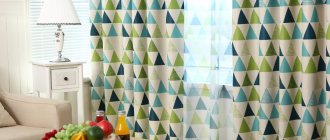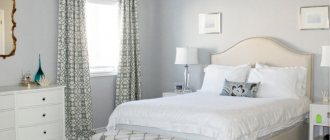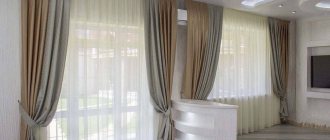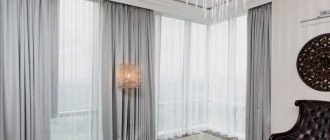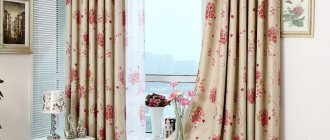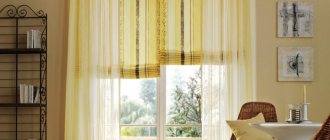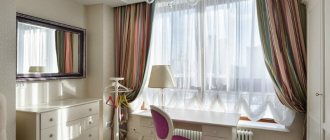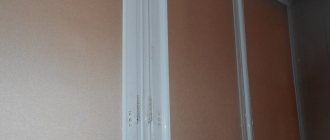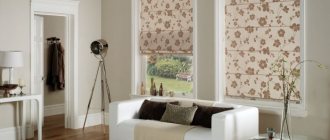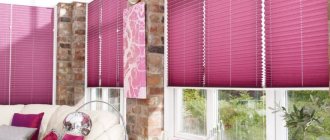Each house has its own, unique atmosphere. It is created by the furnishings, household items and curtains. There are no living rooms without windows, and therefore without curtains. After all, an uncurtained window is rarely cozy and warm. Another thing is that you can close it lightly and airily, or you can close it tightly, softly and extravagantly. In the first case, flowing thin fabrics such as organza and chiffon are used; it is permissible to use flounces, gathers and drapery. The color of the curtains may not be in harmony with the overall background. The main feeling of using such curtains is lightness and unobtrusiveness. In addition, using light colors can help visually enlarge the space.
Curtains
For the second case, thick curtains made from materials appropriate to the situation and time of year are needed.
Another name for thick fabric for curtains is curtains (from the French word porte, which translates as “door”).
What is Blackout and its history
Translated from English, Blackout means temporary eclipse (or darken). The name was given to the product due to its functionality. If you close the window, the room becomes dark as night.
For the first time, curtains with such characteristics appeared in the northern latitudes (in Finland), where there are long white nights.
This may cause problems sleeping. As a result, curtains were developed that hide the light source more effectively than classic ones - the familiar model with low light transmission.
Origin of the material and its composition
It is not surprising that blackout technology was developed in Finland. After all, the inhabitants of this northern country suffer most from constant light during the summer white nights. When the largest Finnish clothing company, Blackout Almedahls, began producing a new material, it quickly gained popularity all over the world.
The light-blocking fabric is a 100% polyester fabric made with an extremely tight double satin weave. It consists of three interconnected layers:
- The outer one is white and acts as a light reflector.
- The middle one provides maximum protection from sun rays and is the thickest.
- The inner one performs a decorative function and can be plain or with various patterns and designs.
This three-layer fabric is called dimout, and its light absorption capacity ranges from 70 to 90%. To bring this indicator closer to the maximum possible, several layers of acrylic foam are applied to the dimout, which, when hardened, forms a rubber-like surface. It is this material that is patented under the Black Out trademark.
Interesting to know! Some types of blackout fabric are pre-impregnated with fire retardants. Most often they are used in cinemas to shade the auditorium.
Application area of fabric
The material of such curtains has a high density, so it can be used for various purposes:
- creating scenery in the theater and at various events;
- stage design;
- furniture upholstery, production of covers;
- sewing opaque curtains: curtains with such properties are used wherever it is necessary to periodically create the effect of complete darkness in a room (for example, in a children’s room, cinemas, conference rooms, nightclubs, hotels), since their main goal is to ensure the possibility of full rest in conditions where the room is not dark enough;
- the use of fabric with such properties on the street: due to its high density, it is not exposed to negative external factors, retains its attractiveness, and is used to create signs.
Light-diffusing and reflective fabric: what's the difference?
Curtain materials with low light transmittance are divided into two types:
- light scattering;
- reflective.
The principle of operation of these materials is fundamentally different, and they are used in different conditions. Let's look at how these types of curtains work and which one should be purchased in which situation.
Light-diffusing fabric
Light-diffusing textiles are widely used in the manufacture of advertising signs. It is called backlit. This is due to the design features of the fabric - literally backlit means “lined at the back”. The material has a special polymer coating located on its back side.
The principle of operation of the material is light scattering. In practice, this means that the curtain does not block it completely. But thanks to the layer made of polymer, it dissipates it as much as possible and breaks it down. Thanks to this, light practically does not penetrate into the room.
Of course, in bright light from the street it will be noticeable that the window is glowing. However, this will not cause any discomfort. However, light-diffusing curtain materials are recommended for use in cases where there are no street lights, bright signs, or other sources of bright light nearby.
Most often, light-diffusing material is used in the manufacture of roller blinds. This is also due to its characteristics - it is quite dense, so it is difficult to make traditional curtains or Roman blinds from it.
Reflective fabric
Reflective fabric does not scatter light rays, but reflects them. The clearest example of this approach is blackout. This material has a special polymer coating on the front side. It reflects up to 90% - 95% of light. Thanks to this, when the curtains are drawn, the room can be completely dark. There are also cheaper, but less effective options (for example, dimout).
Reflective curtains can be divided into two large groups:
- double-layer – on the front side of the curtain there is a layer of polymer coating that reflects light;
- woven - polymer reflective threads are woven into textiles (usually there is 1 reflective thread for 2 regular threads).
These curtains are suitable for windows next to which there are bright light sources that disturb you at night (for example, neon signs).
What is the difference?
The difference between light-diffusing and reflective curtains is that:
- the former evenly distribute light over their surface, thereby making it less intense;
- the latter reflect light and do not let it into the room at all.
In practice, this means that backlit curtains do not provide complete darkness in the room. With their help you can achieve twilight. However, for most people it will be quite comfortable. Blackout and their analogues, on the contrary, guarantee complete (or almost complete) darkness in the room.
Types and composition of fabrics used
There are 5 types of fabric:
- Original: made of polyester, has a high density - 274 g/m². Based on this fabric, others are produced.
- Non-flammable: Trevira fibers are introduced into the material (not subject to combustion), which increases the safety of the product and reduces its rigidity. In terms of this parameter, curtains outperform other types of non-flammable fabrics that have received new properties due to impregnation.
- Linen: this curtain is created on the basis of a natural material, with polyester fibers added to the structure. Due to this, a relief surface is created, since the fibers are different in thickness.
- Gloss: the properties of the material do not differ from the original, but satin fibers are introduced into the structure. This promotes shine.
- Street: properties make it possible to use this canvas for creating street signs and advertising. The fabric is characterized by high density, rigidity, and resistance to negative external factors.
Blackout fabric composition
The fabric contains three textile bases, acrylic foam and a certain set of chemicals. In an effort to increase the fire resistance component, a number of fabric manufacturers impregnate this type of textile with a special composition.
Each of the three layers of material is made using a special thread weaving technology, which makes all layers very thin. When the layers are combined, a very dense fabric is formed with the above unique properties.
Production technology
If we take standard methods for making curtains that do not transmit light as a basis, then the effectiveness of protection from sunlight will be low.
To achieve the desired result, it is necessary to use another technology:
- It is based on a 3-strand weaving method.
- The material is 3-layer, and the outer surface (the one facing the room) should be attractive and smooth. This will improve the appearance of the room and increase ease of use, but this layer must be resistant to wear.
- The middle layer provides protection from light and is made of black polyester thread.
- The inner side reflects the rays (therefore often produced in white), it faces the window.
- To increase efficiency, special foam (acrylic composition) is used.
At the last stage, the product is improved: a print is applied and dyeing is performed. Compositions are used that prevent contamination or impart fire-resistant qualities to the canvas. There are not only 3-layer, but also 2-layer curtains, but they are thinner.
Methods of weaving blackout fabric
Possible options:
- imitation of linen material: this fabric is more embossed on the front side;
- adding satin threads (they enhance shine);
- The design is made using the jacquard technique; it is created by weaving the same name, while the decorative element rises slightly above the main material, forming a relief.
Available design methods: plain canvas, with a pattern.
Fabrics
What are the requirements for thick fabrics for window coverings? They should be:
- Beautiful;
- Practical;
- Easy to maintain;
- Soundproofing and light-absorbing.
Quite a few materials recommended by manufacturers for these purposes meet these requirements. The main thing is that the raw materials used for manufacturing are safe, low-allergenic and do not contain components prohibited for residential areas.
Related article: The door lock is broken: what to do in this case and how to deal with the problem?
Natural
Many housewives are sure that only everything natural can be useful. Such fabrics are really recommended for residential premises. It’s easy to breathe with them, the original design improves the psycho-emotional state of the apartment’s inhabitants, they are easy to wash, iron and are economically feasible. Models in the style of roller blinds (Roman blinds) or ensembles of lambrequins can be made from particularly dense materials.
A variety of natural fabrics is artificial, for example, viscose. For their production, a special method of processing natural fibers is used. Viscose curtains are popular in rooms that require frequent general cleaning and are regularly saturated with tobacco smoke, cooking odors and other aromas.
The price for thick curtains is 7,000 - 8,000 rubles.
Synthetics
Curtains made of thick fabric can also be made of synthetic fiber. They are not inferior to their natural “colleagues”, but at the same time they have:
- High wear resistance;
- Do not burn out;
- Easily washed and does not fade;
- Colors do not change over time;
- Various fastening mechanisms are not excluded;
- They go well with light curtain fabrics and additional decorations.
WATCH VIDEO INSTRUCTIONS
The densest fabric for curtains from this category of materials is polyester or acrylic, a little less dense is nylon.
Knowing these rules, we can choose thick curtains without any problems.
Installation features
There are different types of fastening curtains that darken curtains:
- fixation on the cornice, in this case 2 curtains are provided, they can be purchased as a set;
- mounting on a shaft, as a result, non-transparent products fit more tightly to the wall/frame (depending on the installation method);
- The use of the “mini-roll” design is a compact product designed for mounting on the sash and fixed to the frame.
How to choose heavy fabrics for curtains?
The choice of material depends on the intended style. To make a lambrequin, dense, little draped fabrics are used, and for panels, more elastic ones are used, allowing you to create beautiful soft folds, as in the photo.
To select the right fabric, experts recommend trying it on against a window at different times of the day to determine whether its color, which has changed due to street lighting, will suit your interior. This is especially true for shiny fabrics - satin, silk, satin - and stretch.
Advantages and disadvantages
Before using light-blocking curtains, you need to compare their properties with alternative options.
Advantages:
- light absorption;
- partial sound insulation;
- protection from cold air (this result is achieved if the window is closed with curtains);
- UV resistance;
- low risk of fabric shedding and deformation during washing;
- no kinks or folds during use;
- high wear resistance;
- no toxic substances: the fabric is hypoallergenic.
Flaws:
- the products are quite expensive;
- curtains that create a curtain of light are not universal, which means they cannot be hung in any room - you need to choose a model that suits the style of the interior.
Classification of Black out fabrics
There are several types of material, differing in composition, pre-treatment method and purpose. The most common ones include the following:
- Black out original. It has a three-layer satin weave and is made of polyester fibers. It has a high degree of protection from sunlight and significant wear resistance. It is most often used at home.
- Black out linen. The front side of the fabric imitates linen, which makes it possible to use it for various interior draperies in Mediterranean, antique or rustic style.
- Black out street. This opaque type of material undergoes preliminary impregnation and processing, due to which it has increased strength and resistance to atmospheric phenomena: wind, rain, snow, temperature changes. Used for making advertising posters and banners.
- Black out shine. The canvas has an attractive silver color and glossy shine. This effect is achieved through the inclusion of satin or metallic threads in the fabric.
- Black out fire stop. The material is woven from polyester fibers with a fire-retardant effect. It is used in places with large crowds of people: cinemas, exhibition halls, shopping centers, etc.
Interesting to know! This curtain fabric is made from special non-flammable polyester fibers that do not lose their properties even after numerous washes . In the event of a fire, Black out matter prevents the flame from igniting: it smolders for a short time and then goes out completely. It is noteworthy that practically no toxins harmful to the human body are released.
Recommendations for caring for blackout curtains
To maintain the attractiveness of the curtains and to ensure that the room is effectively protected from the sun, the products should be washed and ironed correctly. For example, it is recommended to dry them in natural conditions; you should not hang them in the sun.
Wash
Sufficient water temperature is no more than +40°C. Violation of this rule will lead to changes in the properties of the product. Machine washing is allowed (but choose a delicate cycle), the spin speed should be minimal - no more than 400 rpm.
Ironing
It is acceptable to straighten folds in this way.
When choosing a temperature mode, the structure and properties of the fabric are taken into account; the sole of the iron should be warm.
It is necessary to constantly monitor the condition of the material so as not to spoil it.
Heavy curtains
Let's look at the secrets of choosing heavy curtains or, more simply, curtains for the living room, hall, kitchen and bedroom. Traditionally, curtains perform not only decorative, but also protective functions against:
- Sveta,
- dust,
- noise,
- drafts.
The desired effects are achieved using heavy, very dense fabrics. Over time, natural raw materials for their production have been partially replaced by synthetic and semi-synthetic ones. Modern materials have received additional positive properties: increased elasticity contributes to better drapery, artificial threads prevent fabric from creasing and increase density, high-quality dyes prevent the material from quickly fading in the sun.
An important feature: an increase in fabric density and a decrease in light transmission is achieved by increasing the number of its layers. High-quality heavy curtains have two or three layers, one of which is linen, cotton or wool.
Design and combination options in the interior
There are 2 ways to decorate an apartment window:
- classic blackout curtains (open in opposite directions from each other), installed on any type of curtain rods, they can be combined with curtains, as they are high-density, light-proof, for this reason their combination with transparent curtains is welcome in many rooms;
- roller blinds that block light: they are often used without curtains.
Classic blackout curtains come in 2 versions: single-sided (moved to one side - left/right), double-sided. To increase their efficiency, suction cups are provided - with their help, the product is attached to the PVC frame for a tighter fit to it.
Tulle materials for window decoration in the kitchen
Curtains made of light fabrics create a feeling of lightness, freely transmit light, easily drape without weighing down the interior, and do not interfere with the flow of fresh air into the room.
Satin
Satin is light and durable, hypoallergenic if made from artificial fibers. The fabric does not wrinkle and is machine washable. Satin is suitable for Alpine, Roman, Japanese or French curtains.
Satin is made from artificial fibers.
Chiffon
The material can be used independently or in combination with other methods of decorating a window opening (for example, on top of Roman blinds). Chiffon goes well with additional decor (braid, tiebacks, hairpins).
Organza
Organza curtains are one of the most practical and versatile products. You can choose shortened or standard length models, 2-layer ones, in which the inner layer is plain, the outer layer has a pattern or embroidery.
Organza is a practical and versatile fabric.
Tulle
Thin fabric with lace weave is a traditional solution for decorating a window opening. The material looks good in combination with thicker curtains or in the form of shortened curtains.
Veil
Translucent material based on silk or cotton, which is suitable for classic interiors, curtains with draperies.
Veil is a translucent material.
Kiseya
Thread curtains can be combined with curtains made from any fabric. Original options are obtained by combining 2 types of muslin, differing in color or texture. The material can be used to decorate the entrance to the loggia or on top of Roman blinds.
Design types of sun blinds
Such curtains differ in the method of opening, design, and the effectiveness of protecting the room from light.
Roman
Curtains consist of folds that are fixed in any position of the canvas. When they are lifted, the design is maintained - the pleats gather neatly at the top. The curtain will remain in this position until it is straightened. Moreover, the folds are large. This design makes the curtains universal; they are suitable for any object.
Japanese
The design fits into interiors decorated in oriental style.
Japanese curtains are an option with a moderately rigid frame on which the fabric is stretched.
The advantage of curtains of this type is their tight fit to the walls due to rigid slats around the perimeter.
Blinds
This group includes roll structures. The light-proof fabric is fixed on the shaft and is raised using an electric drive or a chain. The cassette is installed above the window or directly on the window profile, thereby increasing the effectiveness of light protection - the material adheres tightly to the surfaces.
Zebra, or day and night
Products in this group work on the same principle as roller blinds. Only instead of a plain light-proof fabric, striped fabric is provided. When the material shifts, the position of the strips relative to each other changes, which allows you to open or, conversely, close the windows.
Italian
In this case, the curtain consists of 2 panels located on the sides of the window. They cross at the top. From below, the curtains only partially cover the window opening, as they are held in place by side hooks. If necessary, the fixation is loosened and the curtains are hung completely.
Austrian
The design of this type of product is more complex than others. In the center they are gathered into scallops, the rest of the material is fixed on the sides with cords. To protect the room from light, you need to lower the festoons, for which a special mechanism is used.
French
Such curtains are in many ways similar to Austrian ones, but they have a significant difference - the material is assembled along the entire height, and not just at the bottom. This contributes to the formation of a large number of folds, improves the appearance of the curtains and gives them solemnity.
London
When the curtains are raised, voluminous garlands and large folds of fabric are formed. Most often, this option is used when decorating a window opening in the kitchen.
Pleated
This variety is suitable for country houses and interiors decorated in a style close to oriental. Pleated products can rise in different ways (along the entire length, on one side), which allows you to open the window in different ways.
Double
The classic version - consists of 2 canvases located on the sides of the window. Often, grabs are used in the open position to secure the material.
Thick fabric curtain
The choice of dense material and product style must be approached in a differentiated manner: you should take into account the purpose of the room, its size, the quantity and characteristics of furniture, the presence of household items, decorations and flowers.
To the kitchen
It is recommended to make thick curtains for the kitchen from thin natural fabrics, such as linen or cotton. It is desirable that the material be impregnated against the absorption of odors, containing dust- and grease-repellent components. The curtains in this room should not be long; it is preferable to choose a length just below the window opening. They:
- should not make cleaning difficult,
- easy to wash and iron;
- Empty a window or window without any problems;
- do not have a pressing or binding effect.
Related article: Liquid silk wallpaper: an alternative solution for room walls
Thick roller blinds are very suitable, they can be used intermittently and can be closed as needed.
The colors for kitchen curtains are suitable in warm, light tones, perhaps echoing the colors of the tablecloth, kitchen gadgets or blend of furniture.
We accept cotton for curtains with a discreet harmonious pattern, made by embroidery, appliqué or stamping.
To the bedroom
Thick curtains for the bedroom are a necessary component. A relaxation room cannot have bright natural light and a constantly exciting aura. For proper rest you need:
- Calm tone of furniture and curtains;
- Discreet and neat style of fabric elements;
- Color harmony of curtains, bedspreads, blankets, capes and other accessories.
Bedroom
Thick light curtains look very noble here. They are soft, calm, cozy and aesthetic. Must create an atmosphere of security and harmony.
Thick material for bedroom curtains can be selected from artificial and synthetic materials. For classic ones, velvet, brocade and satin can be used. Japanese and Arabic curtains require silk, moire, voile fabric and others. The main thing is the presence of painting or embroidery. French motifs are characterized by luxury, voluminous folds and glamour. Made, for example, from taffeta, they create the atmosphere of palace boudoirs and royal chambers.
The most creative individuals will choose curtains made of synthetic materials, decorated with rhinestones, shiny threads and even Swarovski stones.
It is possible to use styles with lambrequins, fringe, silk ribbons and drapery. It is original to use velor fabric for curtains for such a simple model.
To enhance the light and sound protection properties, you can use double-sided thick curtains. They will make the windows look original and well-groomed on the outside and harmonious on the inside.
In the hall and living room
The hall and living room are a place for communication, exchange of impressions, discussion of pressing problems and exchange of good news. How often it is here that fundamental ideas are born and vital decisions are made. Therefore, it is here that nothing should hinder the train of thought and give the inhabitants of the room space for imagination.
Related article: How to lay a baseboard on linoleum: installation methods
Fabric for thick curtains in such an area is a particularly important matter. It doesn’t really matter how natural the raw materials are used in its production. Modern synthetic dense fabrics for curtains, especially from well-known manufacturers, are made from low-allergenic, environmentally friendly fibers, and natural ingredients are almost always added to them. But they are easier to care for and more practical.
Thick curtain fabric for the hall and living room can be satin, velvet, corduroy or gabardine. These are fabrics that have a fairly dense structure, but do not weigh down the product and create a feeling of luxury.
If you want to combine two or more colors in one product, you can use jacquard, the structure of which is an interweaving of threads.
The perfection of the ensemble is created by the correct choice of fastening. Thick fabric for curtains has eyelets that are attached to it by sewing in, thereby reducing breakage or falling to zero. Although options for fastening on rings and clothespins are not excluded. The owner's opinion is the boss of everything.
Thick white curtains are more suitable for room design made in very light light: beige, apricot, pastel and just white. At the same time, working on contrast is a rewarding task. A white piano against the background of a heavy burgundy curtain that flows smoothly to its legs.
A thick curtain in the hall, especially in dark shades, is not a light-protecting whim. This is also:
- Reducing free space
- Creating a style;
- Limitations on the choice of indoor plants with an emphasis on shade-tolerant species;
- Maintaining the line between conservatism and modernism.
Reflective curtains - main properties and advantages
On the outside the curtain is light (white, silver). Due to this, the sun's rays are reflected. The desired effect is achieved through spraying.
Advantages:
- opacity is 100%;
- thermal insulation, in summer it is cooler in such a room, because the heating of the air is reduced (the sun's rays do not penetrate into the room);
- soundproofing.
Fabrics used
To increase the effectiveness of protecting a room from sunlight, special materials are used. The best way to cope with this task is fabric with a PVC coating applied on the reverse side.
Caring for Lightproof Fabrics
Before you start washing or cleaning products made from Black out material, you should familiarize yourself with the manufacturer’s recommendations, which are printed on the label in the form of icons. General rules include the following:
- Curtains can be washed by hand or in a machine. In this case, the water temperature should not exceed 400C.
- Spin should be set to no more than 400 rpm. After this, the product must be hung to dry, avoiding places where there are heating devices.
- Since the fabric does not wrinkle or form creases, there is no need for ironing.
All blackout materials are stain-resistant, so curtains made from this fabric do not need frequent washing. This is usually done once every six months when replacing a summer set of curtains with a winter one and vice versa.
Important fact! Black out material belongs to the expensive category, which is not surprising, given all its advantages. Therefore, in order not to get into trouble when buying and not to buy a fake, the fabric should be checked. If you make a cut on real material, you will clearly see its three-layer structure, as well as the black threads that make up the central layer.
Curtains made from opaque blackout fabric are a great way to instantly transform a bright room into a shaded one. In a room with such curtains you can relax comfortably and peacefully, without being distracted by the sun's rays or extraneous noise.
How else to protect yourself from excess light
To protect from excess light, special types of curtains are used, as well as alternative methods of installing them.
Blinds inside double glazed windows
Thanks to this installation method, the slats are protected from dust and do not require maintenance. However, it can only be implemented during the production of a window unit - it is necessary to include the possibility of installing blinds inside a double-glazed window, which is difficult to do at the operational stage.
External roller shutters
These are universal type designs. They protect double-glazed windows from hail, rain, and debris raised by strong winds. In addition, when closing the roller shutters, the room is protected from sunlight. Such designs are distinguished by 100 percent light transmittance. Installed outdoors.
Roller shutters
This type belongs to the group of roller shutters. They are controlled automatically and are also located outside the object on the windows. Roller shutters prevent the sun from entering the room, and at the same time provide security against intruders.
Awnings
This is what awnings are called. Installed outside the house - at the top of the windows. They correspond in size (mainly in width) to the window block. However, in height they cover only part of the opening, but this is enough to protect the room from the sun.
Inspire Blackout curtains
The production of such a variety of textiles as Blackout curtains is established at many manufacturing enterprises around the world, and the most famous of them are Junkers & Mullers GmbH from Germany, Calcutta in Belgium and Coulisse from Holland.
Blackout curtains are also produced in Russia. Leroy Merlin, for example, offers its customers roller blinds produced under its own Inspire brand.
Inspire plain roller blinds in the right color fit perfectly into almost any room with any design. The filter is suitable for darkening a bedroom or nursery, for an office, a home theater, for the convenience of working at a computer. Light or dark fabric without prints or with an unobtrusive, dim pattern can be successfully combined with textiles of second additional curtains of any color, wallpaper and other materials in the interior. The fabric is impregnated with special compounds that make it easier to care for roller blinds. To clean dust and other contaminants, simply wipe such a curtain with a damp cloth.
The Blackout Inspire roller blind has the following advantages:
- The fabric coating does not transmit light.
- Simplicity and ease of care.
- Attractive price.
- Suitable for any interior and any room in the house.
In the Leroy Merlin chain of stores you can choose roller blinds of various colors and sizes, both plain and with original patterns to suit every taste.
Photos of sun-protection and blackout curtains in the interior
When choosing a product, pay attention to the correspondence of the curtains to the design in which the room is decorated:
- 2-sided curtains - for a room decorated in a classic style;
- roll - for rooms of modern design (high-tech, minimalism).
You can preview photos of ready-made solutions. This will help you choose the appropriate option.
Advantages
The interior of the room will benefit if, taking into account the purpose:
- choose the appropriate fabric for the curtains;
- correctly determine the style;
- select the fastening mechanism.
A curtain made of dense material is characterized by a number of undeniable advantages:
- Softens bright sunlight and extinguishes ultraviolet rays;
- Fills the free space around the window opening;
- Adjusts the overall direction of the design;
- Depending on the color, it gives the room an emotional characteristic;
- Can visually increase or decrease the height of the ceiling;
- It is soundproofed.
This option for closing windows is especially suitable for residents of lower floors or one-story buildings located in close proximity to each other. Many people do not like it when strangers, by looking into the windows, witness the life scenes of the owners.
Features of crocheted kitchen curtains
Knitted curtains (loin knitting, macrame techniques, etc.) are distinguished by a variety of patterns and colors, but their creation takes a lot of time, and the finished products require careful care. They must be washed by hand at a temperature not exceeding 30°C using liquid detergent, and should not be wrung out or stretched when wet.
Knitted curtains are varied.
